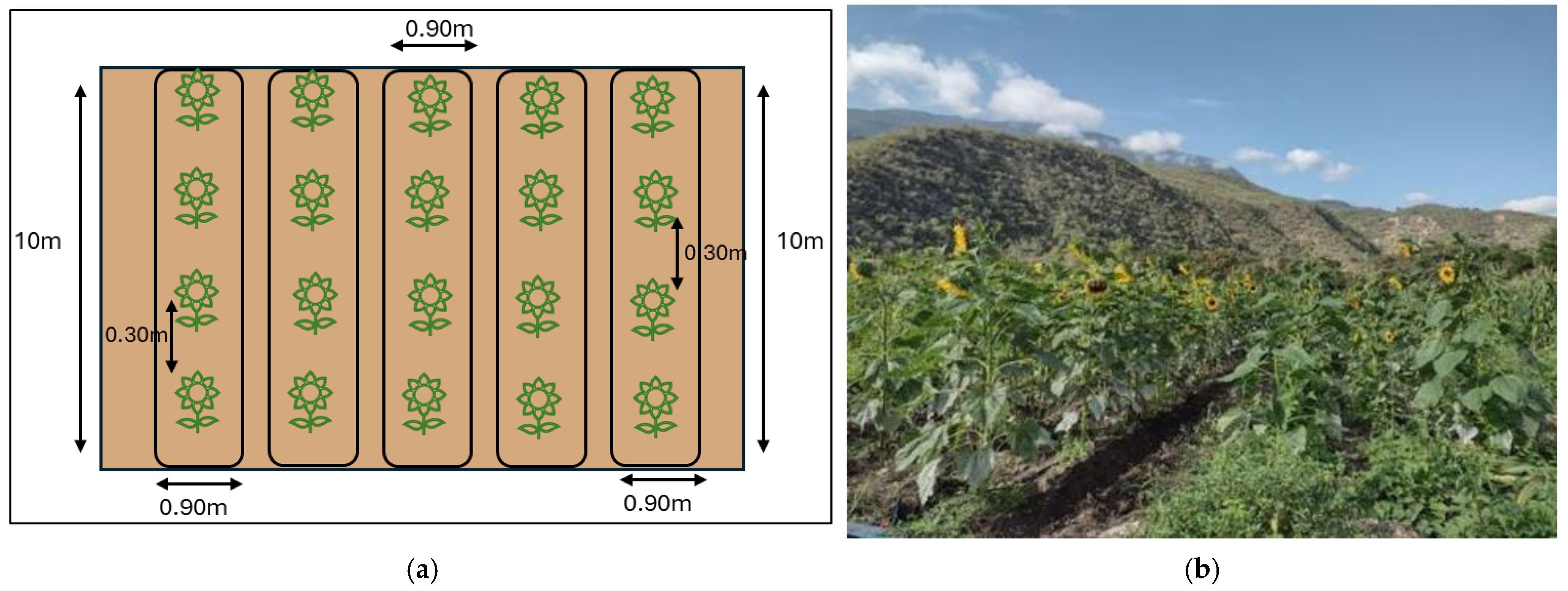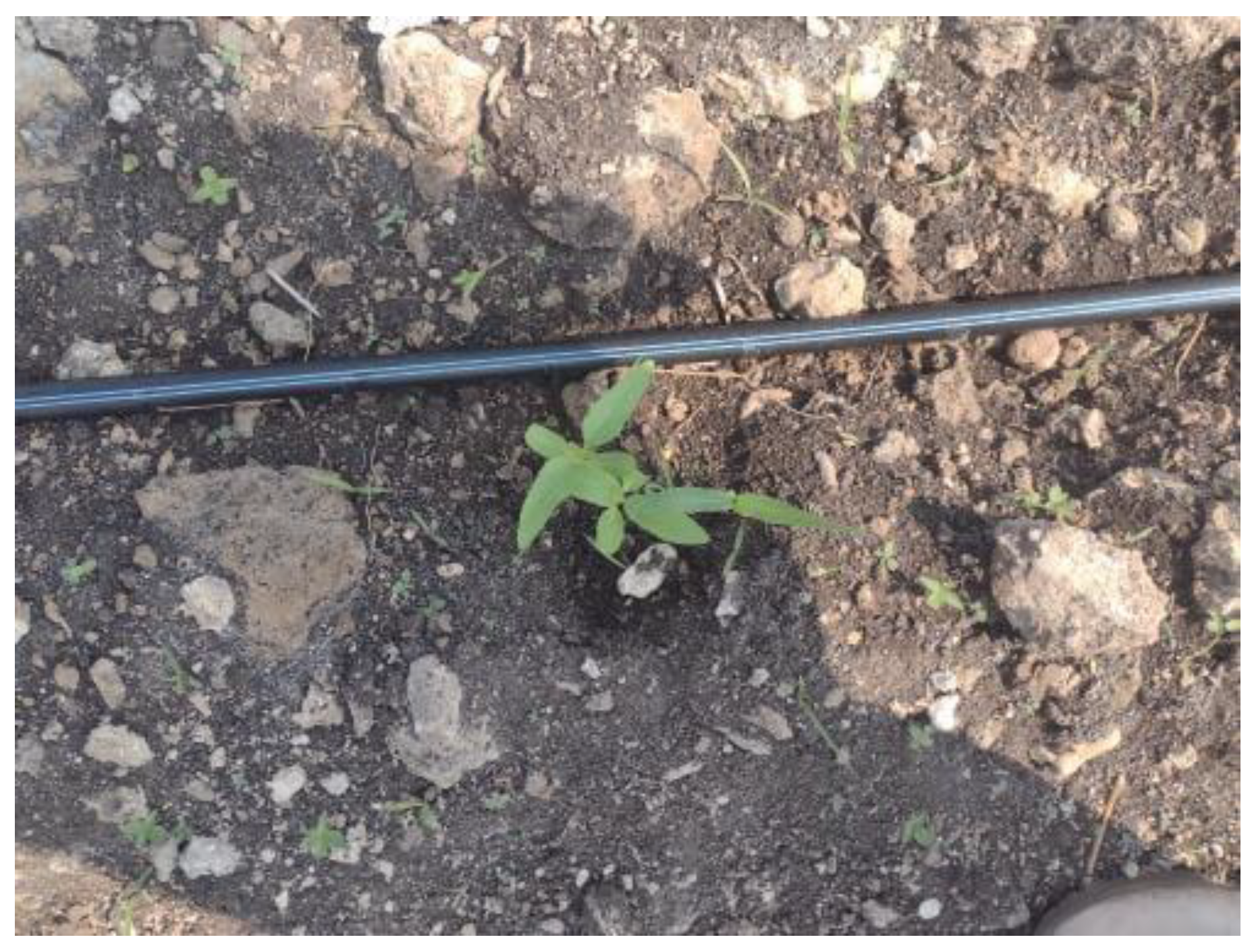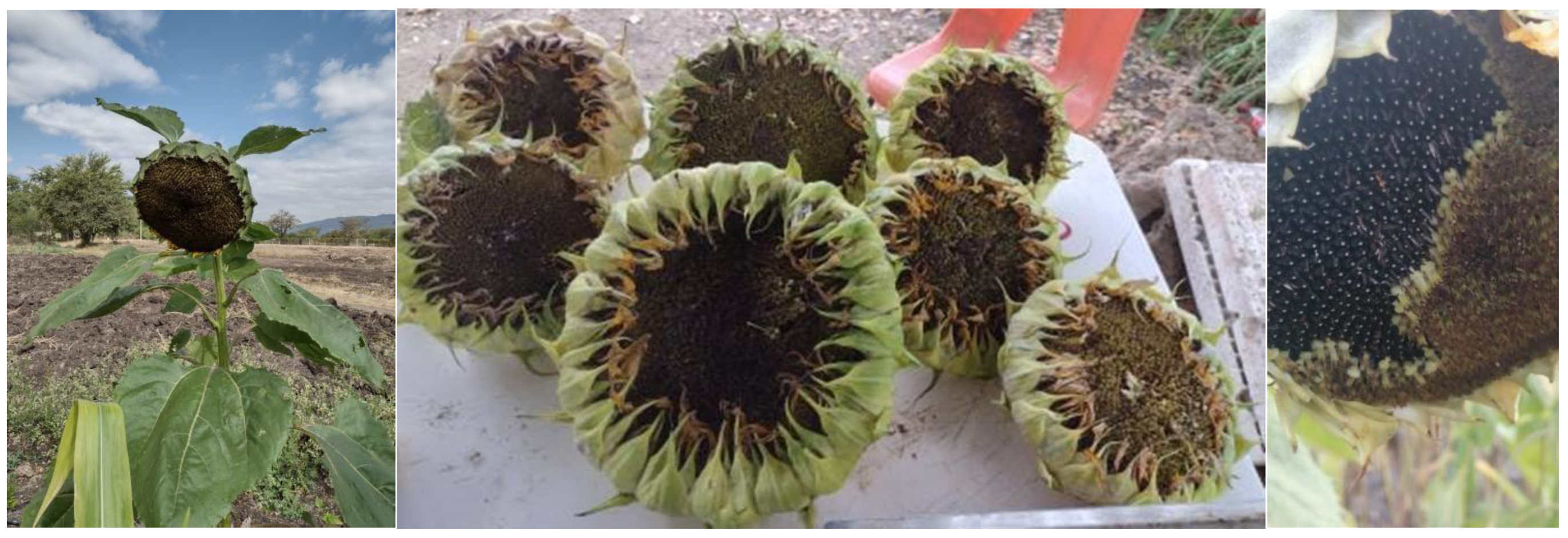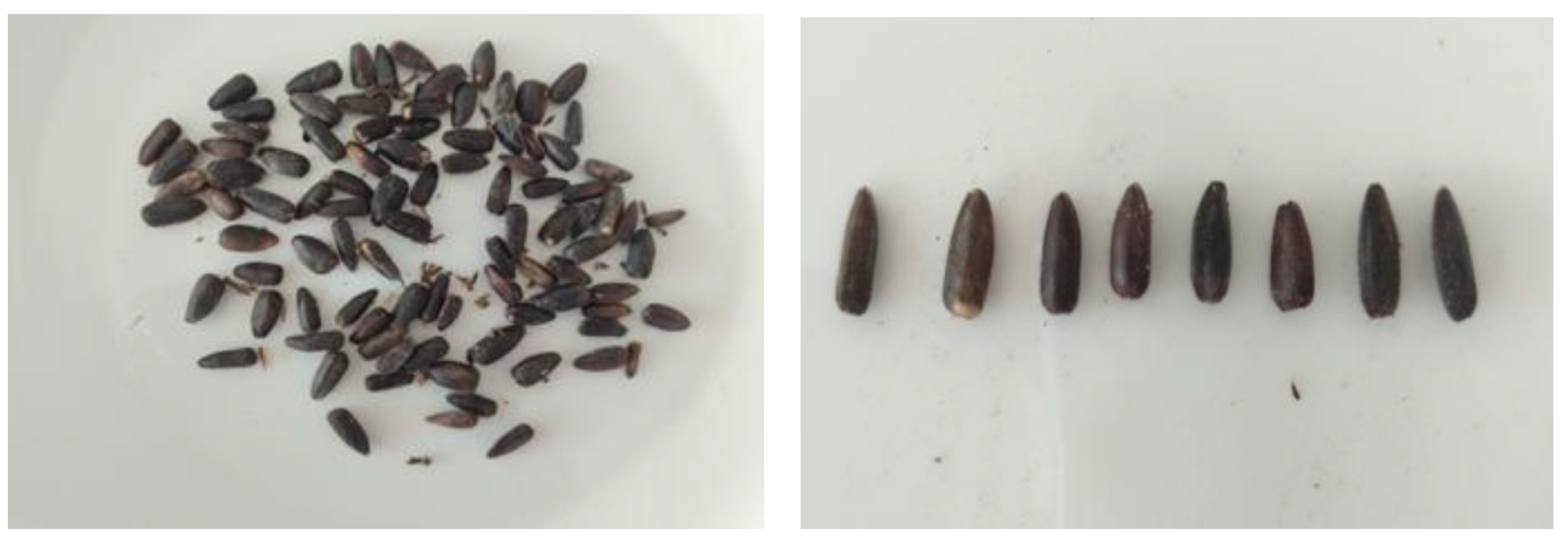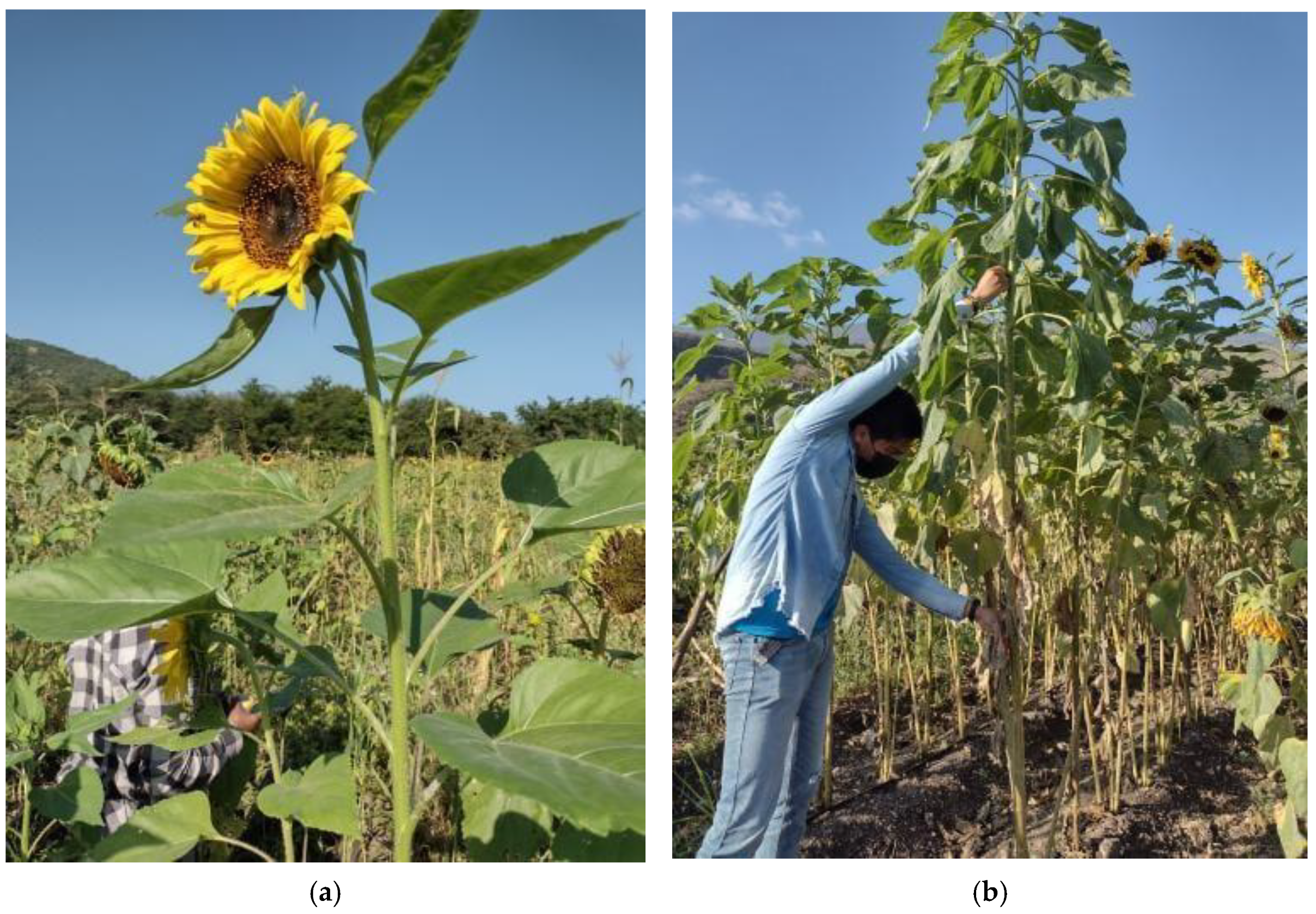3.2. Chemical Composition of Native Sunflower Seeds
The results of many of the analyses performed in this study were compared with other types of oilseeds grown and consumed in Mexico, to compare their nutritional potential with that of maíz de teja. All these seeds are grown in Mexico; however, a large percentage of them are imported into the country. For example, soybeans are one of the main oilseeds consumed in Mexico, with national consumption of 6.1 million tons. However, they are the main oilseed imported by this country, with approximately 95% coming primarily from the USA. It is primarily used as edible oil (36% of total oils consumed in Mexico); its meal is also added to livestock and poultry feed [
45].
Another important oilseed is canola; the demand for its edible oil has grown in recent years because it is a vegetable oil that is low in saturated fat. Its estimated consumption in 2024 was 500,000 tons. Nevertheless, almost 100% is imported to Mexico and is widely used in the edible oil and margarine industries [
46].
Sunflower is widely consumed in Mexico as vegetable oil, and its seeds are consumed as a snack. Despite being a species endemic to Mexico, its production is limited in the country, as both the oil and the seed must be imported to cover the estimated annual consumption of 140,000 tons, as many snack-type products produced in the country contain sunflower oil [
47]. Regarding safflower, Mexico was a leading producer of this oilseed for many years, yet the planted area has declined. It is used as edible oil and for the cosmetics industry. Currently, consumption is 90,000 tons, with a national production of 30,000 tons annually. Therefore, the remainder must be imported from other countries. Furthermore, sesame is an oilseed widely consumed in the country, primarily used in bakeries, confectionery, and traditional cooking (mole, candy) [
46]. Mexico produces a large portion of what is consumed (20,000 tons annually). Other oilseeds consumed in smaller quantities but of regional importance are peanuts, flaxseeds, almonds, and walnuts. They are typically used in gourmet oils, baking, and as seeds. Nonetheless, it should be noted that these oilseeds have a high added value, so a smaller percentage of the Mexican population consumes them. In relation to the above, it is of interest to review the nutritional composition of this native seed, since the country generally requires the availability of other sources of oilseeds [
47].
The results of the chemical analysis showed the moisture and ash content (4.24% and 3.67% respectively), and the percentage of nutrients: 46% lipids, 18% protein, 21.75% fiber, and 6.56% carbohydrates. Compared to another study where bromatological analyses were performed on a sunflower seed carried out by Ortiz-Hernández et al. [
48], the native sunflower seed in the present study has a higher amount of protein (18–14.5 g) and lipids (46–35.70 g) per 100 g, but less fiber (21.75–28.55 g). Another study, carried out in 2020, examined the physico-chemical composition of various domesticated sunflower seed varieties. The results showed that the amount of lipids and fiber is lower in their sunflower seeds (40.33 g and 3.43 g, respectively) [
49], compared to the native oilseed.
Table 3 shows the average nutrient content per 100 g of native sunflower seed compared to other oilseed species grown and consumed in Mexico.
In relation to macronutrients, the native sunflower seeds contain similar amounts of protein to sesame seeds (18 g/100 g) according to Elleuch et al. [
56], but lower than domesticated sunflower seeds (20–40 g/100 g) [
61], and lower than the other seeds with which it is being compared. However, this amount of protein (18 g/100 g) can be compared to or is even greater than the quantity of protein in other basic foods such as eggs (15 g/100 g), natural yogurt (16 g/100 g), and whole milk (12 g/100 g). Even the amount of this macronutrient is greater than that of other oilseeds consumed worldwide, such as walnuts (15 g/100 g) [
62]. Regarding lipids, native sunflower seed contains a higher amount compared to soybean and safflower seeds, as reported by Benito-González et al. [
54] and Hall III [
58], respectively, and a similar amount to peanuts (48 g/100 g) [
59], which makes it viable for oil extraction [
63] since it has an oil content greater than 40% [
55]. Maíz de teja sunflower seed presented the lowest carbohydrate values, which is a positive characteristic for both the process of industry and its consumption [
64]. Finally,
Table 3 shows that the amount of fiber contained in the native sunflower seed is not negligible (21.75 g/100 g) since it exceeds most of the seeds with which it is compared, with only the amount of fiber in the sesame seed being comparable to or greater (26–33 g/100 g) than that in native sunflower seed as found by Elleuch et al. [
56].
3.3. Total Phenolic and Total Flavonoid Contents
Table 4 shows the total phenolic content (TPC) and total flavonoid content (TFC) of the maíz de teja seed analyzed, domesticated sunflower and the six oilseeds to compare. Regarding phenolic compounds, maíz de teja seeds had a much higher TPC in comparation to domesticated sunflower (3.434 ± 0.03 mg/g and 0.8 ± 0.1 mg/g), similar to that of soybeans (3.434 ± 0.03 mg/g and 3.23 ± 0.08 mg/g, respectively) and less than that of the domesticated variety (80 ± 0.3) [
65]. However, the amount of flavonoids is higher (0.67 ± 0.02 mg/g) in maíz de teja compared to four of the oilseeds. Sesame exceeds it (4.99 ± 0.03 mg/g) [
62] and so does domesticated sunflower (1.94 ± 0.2) [
63].
The presence of phenolic compounds and flavonoids in the native variety allows these compounds to act as defense molecules against abiotic and biotic stress. The released compounds (chlorogenic acid, caffeic acid, ferulic acid, among others) participate in the neutralization of free radicals generated during oxidative stress, protecting plant tissues. This helps conserve the biochemical diversity associated with native varieties, maintaining relevant plant genetic resources in the face of climate change, for example [
71]. This reaction stabilizes plant metabolism and stops the initiation and propagation stages of the oxidative reaction, resulting in the effective production of bioactive compounds (eustress). Nevertheless, it is necessary to evaluate the antioxidant capacity of foods, to check whether the bioactive compounds produced are appropriate for consumption.
Research carried out by Piotrowicz-Cieślak et al. [
65] indicates that native varieties tend to accumulate higher levels of phenolic compounds due to their adaptation to environments with greater environmental stress. This accumulation benefits the plant, and in addition, the phenols produced provide antioxidant capacity to the seeds, which contributes to the oxidative stability of the oil that can be obtained, reducing the rate of rancidity [
72] and derived products. Furthermore, this contributes to healthier diets and has a good impact on human health by providing a functional food that is capable of neutralizing free radicals and reducing oxidative damage [
73], and has several antioxidants, anticancer, and anti-inflammatory functions, among others [
74]. This information opens a broad scope for the exploitation of native varieties, enabling them to be used in the development of functional foods with antioxidant properties.
3.4. DPPH and ABTS Antioxidant Activity
The antioxidant activities of these native sunflower seeds were determined using the DPPH and ABTS radical assays.
The results indicated that the extract from native sunflower seeds exhibited antioxidant activity, playing a role as a scavenger of DPPH and ABTS radical cations. The extract from native sunflower seeds showed an average DPPH inhibition percentage of 41.7 ± 0.5% and an average ABTS inhibition percentage of 35.94 ± 1.88%.
The antioxidant capacity of DPPH and ABTS was measured at different times to verify the percentage of inhibition where each reagent neutralizes reactive oxygen species (ROS) and is corroborated by its color change. Antioxidant activity is related to abiotic stress; in native species, these percentages may not be as high because, although they have been implemented in a monoculture, these plants are accustomed to the soil conditions of the area. Other research proves that the production of bioactive compounds (phenols and flavonoids) is related to antioxidant activity: the higher the activity, the greater the production of phenolic compounds and vice versa. This point could agree with the present study since the amount of secondary metabolites produced and the antioxidant activity were medium. However, it shows that there is a positive interaction between the plant, soil, and microbiome [
75]. In DPPH and ABTS tests, sunflower seeds exhibit antioxidant capacity values of 40–75 µmol TE/g (Trolox equivalents per gram of sample). There is evidence that chlorogenic acid and α-tocopherol contribute significantly (>70%) to the total antioxidant capacity of sunflower seeds, so the analysis of these phenolic compounds in tile corn is important for relating them to antioxidant capacity [
73].
The benefits associated with antioxidant activity in the human body are enormous, as we are constantly exposed to ROS through interactions with the environment and our diet. These ROS damage the body by exposing it to constant inflammation (low-grade inflammation), which makes it more susceptible to the onset of various diseases [
76]. Therefore, a diet high in antioxidants could help reduce or eliminate these ROS. Oilseeds are characterized by high amounts of antioxidants, but these characteristics depend on soil conditions and the types of stress to which the plants are subjected. Native seeds, when they are in their natural habitat, may have a positive interaction with the soil microbiota, other climatic aspects, and species that surround them, which could favor the production of various nutrients [
77].
3.5. Fatty Acid Content
Table 5 shows the types and percentages of each fatty acid present in the oil of maíz de teja seed. The fatty acid that predominantly composes this sunflower seed oil is linoleic acid (84.99%), with a saturated fatty acid to polysaturated fatty acid ratio of 1:5; no monounsaturated fatty acids were found in this seed. Velasco and Fernández-Martínez [
78] compared the fatty acid composition of native and domestic sunflower varieties in their study. They reported a linoleic acid content of 50–68% in native seeds, compared with 5–15% in domesticated seeds. Thus, the seed of the tile maize evaluated in this study had the highest percentage of this fatty acid. An important aspect of these authors’ research is that they were able to establish that domesticated seeds of this species produce a greater amount of oleic acid, while native species produce more linoleic acid [
78].
It was reported earlier that cultivated sunflower seeds of different varieties have 61.1% as their maximum value of this fatty acid [
61,
79], which is still lower than that found in the native seed. In addition, other studies reported that sunflower seeds enriched with different bioactives have a lower percentage of linoleic fatty acid compared to the present study (55.90% ± 0.1) [
80], which demonstrates that the native sunflower seed under study still contains a greater amount of this component. Compared to other oilseeds grown in Mexico, Bozan et al. [
81] reported that in safflower seeds, the percentage of linoleic acid was 70.46%. In fact,
Table 5 shows the identification and percentage content of fatty acids in both the native sunflower seed oil from this study and oils from previous studies; the result is the same: the native sunflower seeds are the ones that contain the highest percentage of linoleic acid. They can contribute to the consumption of healthy fats, since it was demonstrated that diets in which at least 5–10% of energy is contributed by ω-6 polyunsaturated fatty acids (PUFAs) have a beneficial effect on serum lipids, which could help to reduce negative impacts on cardiovascular diseases [
61]. Although native sunflower seeds contain the lowest amount of linolenic acid, a study conducted by Salas et al. [
79], which evaluated different varieties of sunflower seeds, did not find a large amount of linolenic acid, confirming the information recorded to date that no variety of sunflower seeds is characterized by a high content of this fatty acid. However, that study mentions the presence of very long-chain saturated fatty acids, such as arachidic acid (C20:0) and behenic acid (C22:0), in the sunflower varieties studied. These fatty acids are not contained in tile corn, which could be a positive aspect for its consumption.
Table 5.
Identification of the main fatty acids, and fatty acid content (% of oil) of native sun-flower, canola, soybean, sesame, safflower, and peanut seeds.
Table 5.
Identification of the main fatty acids, and fatty acid content (% of oil) of native sun-flower, canola, soybean, sesame, safflower, and peanut seeds.
| Oilseeds | Myristic Acid (14:0) | Hexadecanoic Acid (16:0) | Stearic Acid (18:0) | Oleic Acid (18:1) | Linoleic Acid (18:2) | Linolenic Acid (18:3) | Arachidic Acid (20:0) | Eicosenoic Acid (20:1) | Heneicosanoic Acid (21:0) | Docosahexaenoic Acid (22:0) | Tetracosanoic Acid (24:0) | Ref. |
|---|
| Maíz de teja | N.D | 7.29 | 7.21 | N.D | 84.99 | 0.01 | N.D | N.D | 0.50 | N.D | N.D | _ |
| Domesticated sunflower | N.D | 6.00 | 4.00 | 75.000 | 15.00 | 0.50 | N.D | N.D | N.D | N.D | N.D | [72,78] |
| Canola/rapeseed | N.D | 11.12 | 2.42 | 39.91 | 18.39 | 19.12 | N.D | N.D | N.D | N.D | N.D | [51,67] |
| Soybean | N.D | 12 | 4 | 21 | 55 | 9 | N.D | N.D | N.D | N.D | N.D | [82] |
| Sesame | N.D | 9.39 | 5.51 | 41.36 | 41.25 | 0.35 | N.D | N.D | N.D | N.D | N.D | [83] |
| Safflower | 0.1 | 5.4 | 1.3 | 14.9 | 77.9 | 0.1 | 0.2 | N.D | N.D | N.D | N.D | [84] |
| Peanut | N.D | 9.3 | 1.1 | 35.6 | 20.9 | N.D | 0.3 | 0.7 | N.D | 1.80 | 0.40 | [70] |
It is important to mention that although a physical evaluation of this native seed was not performed, according to some references, it can be classified as a seed used in human snacks or different preparations and as bird feed [
61], which are, in fact, consumed in this rural area. However, this study has also found that it can be used as a seed for oil production due to its high lipid composition, high percentage of linoleic acid, and lack of saturated fatty acids [
85]. These characteristics warrant further study to explore the potential for local oil production.
3.6. Mineral Content
Detailed descriptions of the types of minerals present in native sunflower seeds and other oilseeds along with their relative weight per 100 g are given in
Table 6. These minerals were chosen based on knowledge of the composition of other sunflower seeds.
The ash content in sunflower seeds was 3.6 g. Zinc is found in the highest concentration, followed by magnesium and copper. Iron, calcium, and low amounts of Fe and Ca. A study conducted on sunflower seeds found a similar quantity of ash (2.34 to 3.92 g/100 g) and lower quantities of zinc (2.98 to 4.05 mg/100 g); all the other minerals were higher than in the oilseed in this investigation [
49]. USDA analysis of sunflower seed mineral content showed a lower amount of zinc (5 mg/100 g), indicating that the sunflower seed variety in the study could be regarded as a source of this mineral [
55].
Especially, when comparing the quantities of minerals with other oilseeds (
Table 6), it was seen that the sunflower seed in this study contains the highest levels of zinc (17.28 mg/100 g).
The amount of zinc obtained from maíz de teja was compared with foods high in zinc, such as red meat (2.9–4.7 mg/100 g), organ meats (4.2–6.1 mg/100 g), and seafood (0.5–5.2 mg/100 g) [
91]. Therefore, it is interesting to evaluate the bioavailability of this mineral to know the quantity that is assimilated by the human body, since it is precisely in rural areas where the consumption of quality animal-based foods is scarce, and their decline is often linked to malnutrition, especially in children, which impacts growth [
92,
93].
A detailed analysis of the nutritional profile of maiz de teja in the Sierra de Querétaro reveals its significant potential to contribute to local food security and improve community health. This native variety stands out for its balanced content of essential fatty acids, proteins, and bioactive compounds with antioxidant properties, which is consistent with previous findings in germplasm studies in similar regions [
94,
95]. The presence of phenolic compounds and antioxidants is especially relevant, given that these compounds are associated with a reduced risk of chronic non-communicable diseases, such as cardiovascular disease and certain types of cancer [
96,
97].
Comparatively, the native sunflower of Querétaro presents nutritional profiles that in some cases surpass or equal domesticated and commercially cultivated varieties. For example, studies such as those by Pérez-Vega et al. [
98] show that certain native varieties contain a higher percentage of unsaturated fatty acids, especially linoleic acid, compared to conventional hybrid varieties. This characteristic is not only valuable from a nutritional perspective but also from a technological perspective, as it affects the quality of the oil and its oxidative stability [
99,
100].
Furthermore, when compared to other oilseeds commonly consumed in nearby regions, such as avocado, chia, or sesame, maíz de teja provides a unique profile that can complement the local diet and diversify the supply of nutritious foods [
101,
102]. Its adaptation to the local environment, resistance to pests and diseases, and low requirement for chemical inputs position this variety as a viable option for sustainable agricultural practices that promote biodiversity conservation and agroecological resilience [
103,
104].
The yield of this native species, although it may be lower compared to highly selected commercial or domesticated varieties, should not be viewed exclusively from a quantitative perspective. The nutritional and functional quality of the seed can provide significant added value for local markets and for food security in rural communities, where self-sufficiency and sustainability are priorities [
105,
106].
Finally, this research points out the need for continued studies that integrate agronomic, nutritional, and socioeconomic analyses to optimize the management of native sunflowers in the Sierra de Querétaro. Future research should include evaluating their yield under different sustainable cultivation systems, studying their interaction with local biodiversity, and developing production chains that enhance their nutritional properties for community benefit [
107,
108].
